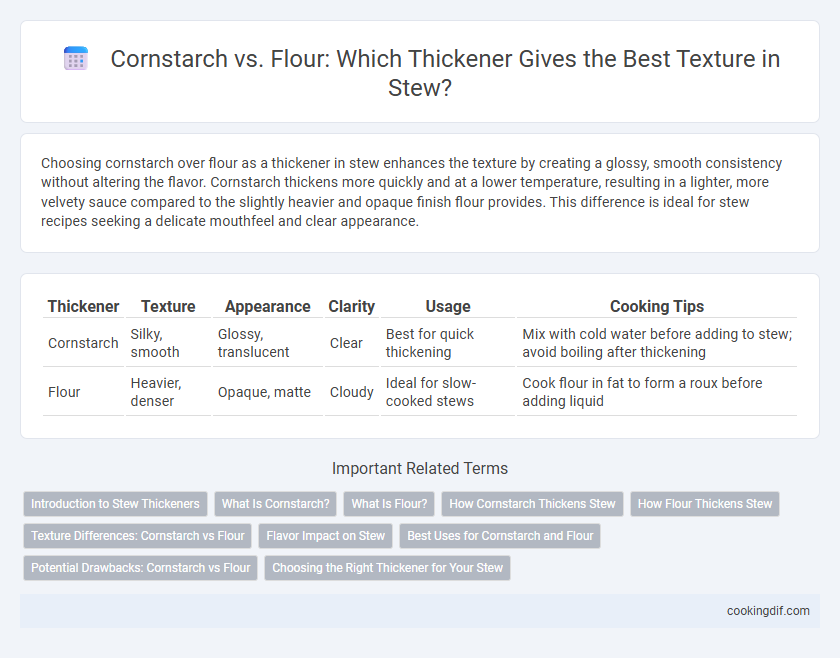Choosing cornstarch over flour as a thickener in stew enhances the texture by creating a glossy, smooth consistency without altering the flavor. Cornstarch thickens more quickly and at a lower temperature, resulting in a lighter, more velvety sauce compared to the slightly heavier and opaque finish flour provides. This difference is ideal for stew recipes seeking a delicate mouthfeel and clear appearance.
Table of Comparison
| Thickener | Texture | Appearance | Clarity | Usage | Cooking Tips |
|---|---|---|---|---|---|
| Cornstarch | Silky, smooth | Glossy, translucent | Clear | Best for quick thickening | Mix with cold water before adding to stew; avoid boiling after thickening |
| Flour | Heavier, denser | Opaque, matte | Cloudy | Ideal for slow-cooked stews | Cook flour in fat to form a roux before adding liquid |
Introduction to Stew Thickeners
Stew thickeners like cornstarch and flour play crucial roles in achieving the desired texture and consistency. Cornstarch, a fine white powder derived from corn, creates a glossy, translucent finish with a smooth texture, thickening liquids quickly at higher temperatures. Flour, made from ground wheat, produces a more opaque and hearty texture, often requiring longer cooking times to eliminate the raw taste and achieve a well-rounded, rich stew base.
What Is Cornstarch?
Cornstarch is a fine, white powder derived from the endosperm of corn kernels, commonly used as a thickening agent in stews for its ability to create a glossy, translucent texture. It thickens liquids quickly at lower temperatures and provides a smooth, silky consistency without altering flavor. Unlike flour, cornstarch forms a more stable gel that holds up well in acidic or frozen stews, making it ideal for achieving a clear and velvety texture.
What Is Flour?
Flour is a fine powder made by grinding grains, most commonly wheat, and serves as a traditional thickening agent in stews by absorbing liquid and swelling to create a hearty, opaque texture. Unlike cornstarch, which provides a glossy finish and a more translucent consistency, flour contributes a richer, fuller mouthfeel and helps develop a deeper flavor through the Maillard reaction during cooking. Its protein and starch content make flour ideal for slow-cooked stews requiring extended simmering to achieve optimal thickness and body.
How Cornstarch Thickens Stew
Cornstarch thickens stew by gelatinizing its starch molecules when heated, forming a smooth, glossy texture that enhances the stew's consistency without cloudiness. Unlike flour, cornstarch creates a clear, velvety finish and requires less quantity to achieve optimal thickness. It is mixed with cold water before adding to the hot stew to prevent clumping and ensure even thickening.
How Flour Thickens Stew
Flour thickens stew by releasing starch molecules when heated, which absorb liquid and swell, creating a smooth, velvety texture. The proteins in flour also contribute to a richer mouthfeel compared to cornstarch, which can sometimes produce a more gelatinous consistency. Using flour as a thickener results in a heartier, more robust stew with a balanced thickness that holds up well during simmering.
Texture Differences: Cornstarch vs Flour
Cornstarch creates a glossy, translucent texture in stew, producing a silkier and smoother consistency compared to flour. Flour thickener yields a more opaque and slightly grainy texture, resulting in a heartier, denser stew base. Using cornstarch typically results in a lighter, more polished finish, while flour provides a richer, more robust mouthfeel.
Flavor Impact on Stew
Cornstarch creates a glossy, translucent texture that enhances the stew's natural flavors without adding any grainy taste, making it ideal for delicate, flavorful broths. Flour thickener imparts a slightly nutty and hearty flavor, which can enrich the stew but may result in a denser, cloudier consistency. Choosing cornstarch preserves the stew's brightness, while flour thickener adds depth and a subtle roasted undertone.
Best Uses for Cornstarch and Flour
Cornstarch produces a glossy, translucent finish ideal for clear stews and sauces, while flour thickens with a more opaque, matte texture suited for hearty, rustic stews. Cornstarch works best in recipes requiring quick thickening at high heat without altering flavor, such as Asian-style or fruity stews. Flour is preferred for slow-cooked, creamy stews or gravies where a richer, more robust texture develops over time.
Potential Drawbacks: Cornstarch vs Flour
Cornstarch can create a glossy, translucent texture in stew but may break down and thin out when reheated or overcooked, leading to a less stable thickening effect. Flour provides a more opaque, hearty texture and holds up better under prolonged simmering but can impart a slightly raw, floury taste if not cooked long enough. Both thickeners require careful balance to avoid undesirable textures, with cornstarch risking a slimy mouthfeel and flour potentially causing a grainy consistency.
Choosing the Right Thickener for Your Stew
Cornstarch creates a glossy, translucent stew with a silky, smooth texture, while flour produces a more opaque, hearty consistency with a slightly grainier mouthfeel. Use cornstarch for quick-thickening and lighter dishes, as it gelatinizes at lower temperatures and yields a delicate finish. Flour is ideal for slow-cooked stews, providing rich body and stability through prolonged simmering and intense heat.
Cornstarch vs Flour Thickener for Texture Infographic

 cookingdif.com
cookingdif.com